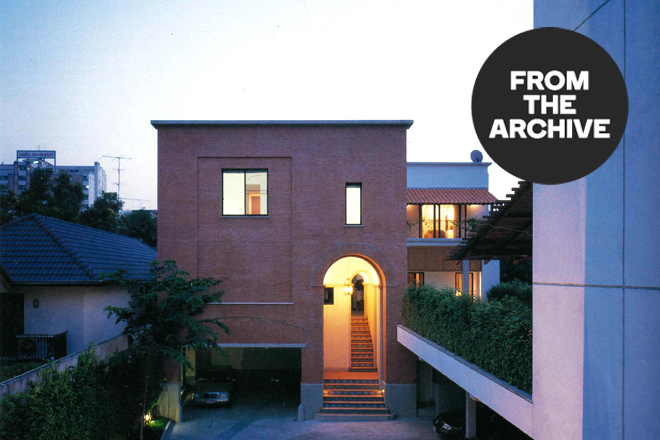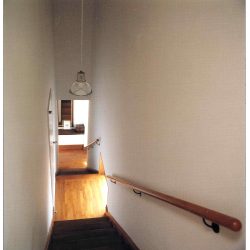LUIS BARRAGAN IS ONE ARCHITECT WHO CREATES SPACE THROUGH A PROCESS CLOSELY LINKED TO THE MIND AND SOUL, LEADING TO THE CREATION OF PEACEFUL SPACES AND FORMS THAT HAVE INSPIRED MANY BUILDINGS IN THE WORLD INCLUDING THE COURTYARD HOUSE DESIGNED BY ONGARD ARCHITECTS.
He once said, “I believe that a work of art reaches perfection when it conveys silent joy and serenity.” Barragan’s work peels away surface embellishments and reveals to us the mystery, dream, spirituality and powerful tranquility that are so much a part of life yet lie hidden most of the time.
His ideas were inspired by Moore space which he saw when he visited Alhambra in Grandada, South of Spain. These peaceful spaces and forms have inspired many buildings in the world including the courtyard house designed by Ongard Architects. Back in 1967, as modern architecture grew, Ongard Satrabhandhu was famous for his Corbusier-influenced Panapan building. His success continued in the post-modern age when he shifted his approach to historicism and pluralism and did buildings such as the gymnasium and library at Panapan school and Toshiba building.

These came from the study of classical works, especially the works of Andreas Palladio (1508-1580). Ongard was influenced by the Frontal Manner and Regulating Lines in particular.

However, Ongard turned away from post-modern philosophy when Jareemarse Building was extremely criticized in 1987. “I found that with this approach I was not making any real progress and my work could not compare with the old works such as those of Joze Plecnik. So I turned to study the works of the past to get a really good start.”

Like many masters, Ongard combines historical aspects in his architecture. “I used the language of Rossi’s classic rules. He did not conceal the original source but still I made it fresh. His writing urged me to think like Corbu. If we see his three-dimensional plans, we’ll see movement that combined the past.”


Ongard’s works reflect his modest personality in the use of natural surface materials and the concern with details in various materials which has been inspired by Baragan, Aldo Rossi, Eric Gunnar Asplund and Leon Krier – contemporary architects who took the post-modern icon, Charles Moore’s place, while the classical proportions and vocabulary of Palladio remained.

Ongard is interested in the spaces of ancient buildings which are full of mysterious feelings, the contrast of dark and light and unexpected space approach such as in the Twin Temples or Nabu at Mesopotamia or Tomb of Seti in Egypt. These influences along with Palladio’s has made his designs during the past 5-8 years more calm. And his “silent joy and serenity” can be seen in his recent courtyard house. As Ongard explained, “This house began with a modern idea but ended up in the Moorish style. I was impressed in Alhambra. I wanted a serene atmosphere so I turned a vernacular style as well as the influence of Baragan in bringing light into the building which is proper for our region like some works of my favorite architects such as Hassan Fathy, Abdel Wahed El-Wakil and Geoffrey Bawa.”

The courtyard house consists of two buildings with interlocking plans to share the same courtyard. Each house has a Moorish portico corridor on the upper floor. The light and shadow through the small courtyard create new perspectives in relation with the nature outside. The classical façade and the background building are in red bricks which contrasts beautifully with the green covers of the trees.


Craftsmanship is very crucial in the works of Ongard Architects. Perhaps the courtyard house is standing on the crossroads of Thai contemporary architectural history before entering the real information age.
Visiting the courtyard house, looking at Alhambra’s pictures and Ongard Architects’ profile, I thought of Mies van de Rohe’s words, “I am a traditionalist and I believe in history, I do not strive for originality. It is much better to be good than to be original.”


HOW HAS THE WAY OF LIVING CHANGED AND HOW WILL THE ARCHITECTURE OF THE HOUSE RESPOND TO THESE CHANGES, DO YOU REFER TO THE PRESENT SITUATION OR MAKE TRAJECTORIES TOWARD THE COMING FUTURE?
Ongard: Most clients have fantasy houses that are extravagant on the outside. As architects we have to satisfy their demands but we also have an obligation to create a building rooted in an understanding and respect for certain general principles of building in the tropical climate.
ARE THERE ANY FAMOUS HOUSES THAT HAVE INSPIRED YOU? WHAT HOUSE DO YOU THINK MIGHT BE THE MOST INFLUENTIAL HOUSE OF THE 20TH CENTURY?
Ongard: In particular, I think of houses in Granada and those designed by Geoffrey Bawa of which I am very impressed. I believe that whomever has been there, be they an architect or not, will be as impressed as I was. What I am now also interested in are works of architecture that are not designed by architects, such as those works in the book, “Architecture without Architect.” They are quite amazing. All the works included in that volume are so interesting. They were designed by those who are so sharp even if unconsciously.

Originally published in art4d No.57, February 2000.




